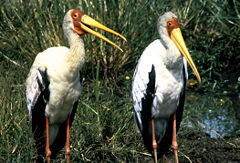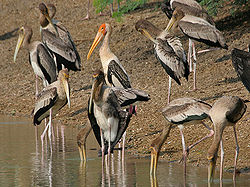- Mycteria
-
Mycteria
Temporal range: Middle Miocene to Recent
Yellow-billed Storks (Mycteria ibis) Scientific classification Kingdom: Animalia Phylum: Chordata Class: Aves Order: Ciconiiformes Family: Ciconiidae Genus: Mycteria
Linnaeus, 1758Species Mycteria cinerea
Mycteria ibis
Mycteria leucocephala
Mycteria americanaSynonyms Dissourodes
Mycteria is a genus of large tropical storks with representatives in the Americas, east Africa and southern and southeastern Asia. Two species have "ibis" in their scientific or old common names, but they are not related to these birds and simply look more similar to an ibis than do other storks.
The Mycteria storks are large birds, typically around 90–100 cm in length with a 150 cm wingspan. The body plumage is mainly white in all the species, with black in the flight feathers of the wings. The Old World species have a bright yellow bill, red or yellow bare facial skin and red legs, but these parts are much duller in the Wood Stork of tropical America. Juvenile birds are a duller version of the adult, generally browner, and with a paler bill.
They are broad-winged soaring birds that fly with the neck outstretched and legs extended. They are resident breeders in lowland wetlands with trees in which build large stick nests.
These storks walk slowly and steadily in shallow open wetlands seeking their prey, which, like that of most of their relatives, consists of fish, frogs and large insects.
Species
- Milky Stork, Mycteria cinerea
- Yellow-billed Stork, Mycteria ibis
- Painted Stork, Mycteria leucocephala
- Wood Stork or "wood ibis", Mycteria americana
Two prehistoric relatives of the Wood Stork have been described from fossils:
- Mycteria milleri (Miller's Stork) (Valentine Middle Miocene of Cherry County, USA) - formerly Dissourodes
- Mycteria wetmorei (Wetmore's Stork) (Late Pleistocene of W and SE USA, and Cuba)
The latter seems to have been a larger sister species of the Wood Stork, which it replaced in prehistoric North America.[1]
Late Miocene tarsometatarsus fragments (Ituzaingó Formation at Paraná, Argentina) are somewhat similar to Mycteria but still distinct enough to be probably a distinct genus, especially considering their age[2]. A Late Pleistocene distal radius from San Josecito Cavern (Mexico) may belong in this genus or in Ciconia[3]. A "ciconiiform" fossil fragment from the Touro Passo Formation found at Arroio Touro Passo (Rio Grande do Sul, Brazil) might be of the living species M. americana; it is at most of Late Pleistocene age, a few 10.000s of years[4].
Footnotes
References
- Cione, Alberto Luis; de las Mercedes Azpelicueta, María; Bond, Mariano; Carlini, Alfredo A.; Casciotta, Jorge R.; Cozzuol, Mario Alberto; de la Fuente, Marcelo; Gasparini, Zulma; Goin, Francisco J.; Noriega, Jorge; Scillatoyané, Gustavo J.; Soibelzon, Leopoldo; Tonni, Eduardo Pedro; Verzi, Diego & Guiomar Vucetich, María (2000): Miocene vertebrates from Entre Ríos province, eastern Argentina. [English with Spanish abstract] In: Aceñolaza, F.G. & Herbst, R. (eds.): El Neógeno de Argentina. INSUGEO Serie Correlación Geológica 14: 191-237. PDF fulltext
- Grimmett, Richard; Inskipp, Carol, Inskipp, Tim & Byers, Clive (1999): Birds of India, Pakistan, Nepal, Bangladesh, Bhutan, Sri Lanka, and the Maldives. Princeton University Press, Princeton, N.J.. ISBN 0-691-04910-6
- Hilty, Steven L. (2003): Birds of Venezuela. Christopher Helm, London. ISBN 0-7136-6418-5
- Noriega, Jorge Ignacio & Cladera, Gerardo (2005): First Record of Leptoptilini (Ciconiiformes: Ciconiidae) in the Neogene of South America. Abstracts of Sixth International Meeting of the Society of Avian Paleontology and Evolution: 47. PDF fulltext
- Schmaltz Hsou, Annie (2007): O estado atual do registro fóssil de répteis e aves no Pleistoceno do Estado do Rio Grande do Sul, Brasil ["The current state of the fossil record of Pleistocene reptiles and birds of Rio Grande do Sul"]. Talk held on 2007-JUN-20 at Quaternário do RS: integrando conhecimento, Canoas, Rio Grande do Sul, Brazil. PDF abstract
- Steadman, David W.; Arroyo-Cabrales, Joaquin; Johnson, Eileen & Guzman, A. Fabiola (1994): New Information on the Late Pleistocene Birds from San Josecito Cave, Nuevo León, Mexico. Condor 96(3): 577-589. DjVu fulltext PDF fulltext
- Suarez, William & Olson, Storrs L. (2003): New Records of Storks (Ciconiidae) from Quaternary Asphalt Deposits in Cuba. Condor 105(1): 150-154. DOI:10.1650/0010-5422(2003)105[150:NROSCF]2.0.CO;2 HTML abstract
Storks (order: Ciconiiformes • family: Ciconiidae) Genus Mycteria Milky Stork (M. cinerea) • Yellow-billed Stork (M. ibis) • Painted Stork (M. leucocephala) • Wood Stork (M. americana)Anastomus Asian Openbill (A. oscitans) • African Openbill (A. lamelligerus)Ciconia Abdim's Stork (C. abdimii) • Woolly-necked Stork (C. episcopus) • Storm's Stork (C. stormi) • Maguari Stork (C. maguari) • Oriental Stork (C. boyciana) • White Stork (C. ciconia) • Black Stork (C. nigra)Ephippiorhynchus Black-necked Stork (E. asiaticus) • Saddle-billed Stork (E. senegalensis)Jabiru American Black-necked Stork or Jabiru (J. mycteria)Leptoptilos 19 living species in six genera Categories:- Mycteria
- Storks
- Genera of birds
Wikimedia Foundation. 2010.

